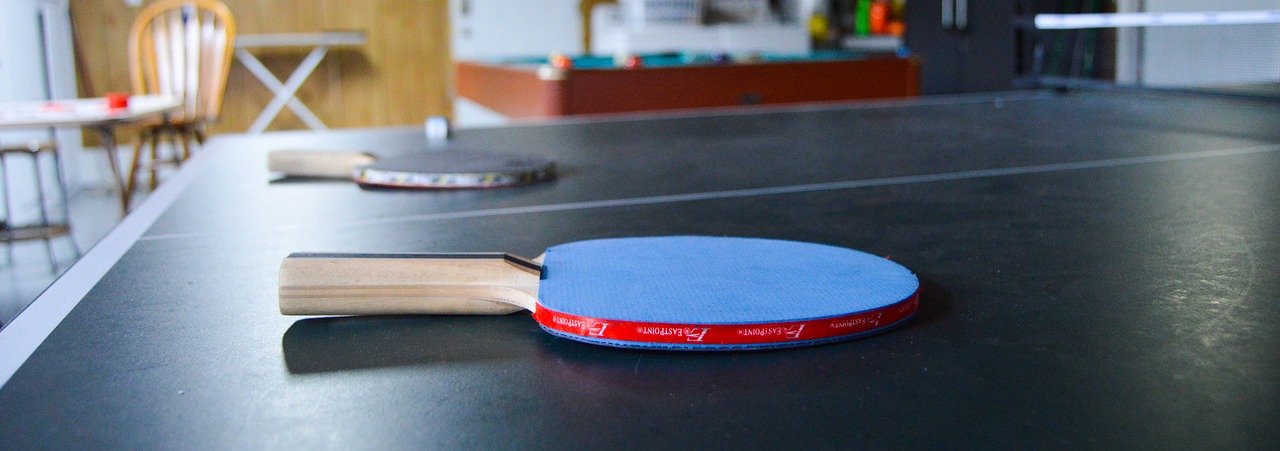
Table tennis and ping pong are often used interchangeably in general conversations. However, there are subtle differences between the two. This article aims to explain the differences and hope to settle the arguments around ping pong vs table tennis. We will explore the intricacies and hopefully we will gain a deeper understanding of the two games.
History
Table tennis and ping pong have their roots in the same game. Table tennis originated in England during the late 19th century as an indoor adaptation of lawn tennis. The name “ping pong” was coined by the Parker Brothers, an American board game company, when they introduced the game in the early 20th century. While both sports have a similar origin, table tennis has gained more recognition and is now an Olympic sport.
Equipment
One of the biggest differences between table tennis and ping pong is the equipment used. To start with the bats are the biggest change. Within table tennis players use high quality – professional grade equipment. This starts with a blade which is the wooden part of the bat. This can be made out of lots of different materials to suit each players style. The blade is then covered with a sheet of rubber on both sides of the blade. These sheets of rubber also have a layer of sponge that goes between the rubber and the blade. All of this is customisable, again so that the players can use the equipment that suits their play style the most.
While ping pong bats may look the same they do have their differences. Firstly, there is now no sponge under the rubber, this means that there is no cushion between the ball and the blade. This creates the iconic sound when hitting the ball. Also, the layer of rubber that is used on table tennis bats is swapped for what is especially sandpaper. This reduces the grip the bats produce and therefore reduces the amount of spin that can be generated.
Lastly, in table tennis you can customise your bat to suit your play style, in ping pong everyone uses the exact same bats. Some see this as a fairer game as everyone is using the same equipment. At the lower levels it removes the element of pay to win.
Rules
For the rules of table tennis you can see this post on the basic rules of table tennis. Here, we will just discuss the rules of ping pong. The scoring system for ping pong is the first to 15 points – the way points are earned is the same as in table tennis. If the score in a game gets to 14-14 the game goes down to a sudden death point which decides the game.
Once per match (not once per game) you may elect to play a double point. The result of this point is doubled if the player who elected to use it is the player who wins it. For example if Alice and Bob were to play a match and Alice elects to use her double point when the score is 10-9 with Alice being on 10. If Alice wins that point the new score would be 12-9. However, if Bob wins that point the score would be 10-10, Bob does not gain the benefit of the double point.
Each player may use their double point at any point during the match however there are two times when you are not allowed to use it. The first being on your opponents serve. This is to keep track of who has and hasn’t used their double point. Also, you can’t use it if you have 13 or 14 points. This is to prevent you from winning a match with the double point.
It is also a standard practice that the during a double point the ball changes colour – usually from white to orange to signify the difference in the point being played. This is obviously limited to the equipment available.
As you can see the whole structure of the game is massively different to table tennis and even more so with this double point aspect. For most people they find the rule set of ping pong to be much more exciting that table tennis. This is due to the next point wins aspect and the double points causing more crucial points.
Professional Level
Table tennis is widely recognized as a highly competitive sport which is played at national and international levels. It is an Olympic sport and has well-established professional tournaments such as the ITTF World Championships. The sport demands exceptional physical stamina, agility, hand-eye coordination, and tactical skills.
Ping pong, while also played competitively in some settings – like the world championship of ping pong – is predominantly a recreational activity. It is commonly enjoyed in homes, clubs, and community centers, where players of all ages and skill levels can participate in a casual and relaxed atmosphere. Some table tennis competitions will hold smaller events throughout like ping pong to try introduce a less competitive and more fun event within a high pressure competition.
Conclusion
In conclusion, while table tennis and ping pong are related, they differ in terms of equipment, rules, competitive level, and perception. Table tennis is a highly competitive sport played with professional-grade equipment and strict regulations, whereas ping pong is a more recreational game with flexible rules and a focus on casual enjoyment. Regardless of which one you prefer, both table tennis and ping pong offer an enjoyable experience and a chance to engage in a thrilling game of skill and agility.



Explored the article on the difference between ping pong and table tennis, and I’m thoroughly impressed! The detailed comparison, clear explanations, and engaging writing style make it an insightful read. This resource is a valuable guide for anyone seeking to understand the nuances of these two sports. Kudos to the author for shedding light on a topic often misunderstood
I am glad you enjoyed this post, I feel it is important to distinguish the differences between the two commonly misused terms.
The article on that highlights the differences between ping pong and table tennis is a valuable resource for clarifying the distinctions between these two terms often used interchangeably. It effectively breaks down the historical, cultural, and technical disparities between the two, providing readers with a deeper understanding of the sport. By addressing common misconceptions, the article serves as an informative guide for enthusiasts and newcomers alike, fostering a more accurate appreciation of the nuanced world of table tennis.
I am glad this post could provide clarity on a subject that is often misunderstood!